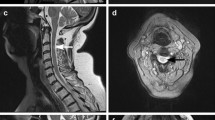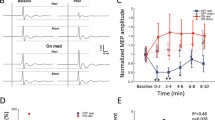Summary
A newly diagnosed patient with Wilson's disease is reported in whom the only clearly pathological neurophysiological findings before treatment were abnormal electromyographic (EMG) responses evoked by transcranial magnetic brain stimulation. Serial examinations over 10 months following commencement of treatment with D-penicillamine revealed normalisation of EMG responses. Pathophysiologically, the initially abnormal EMG responses probably resulted from reversible impairment of impulse propagation along corticomotoneuronal pathways and/or a reduced excitability of cortical cells due to impaired function of the basal ganglia.
Similar content being viewed by others
References
Barker AT, Freeston JL, Jalinous R, Jarrat JA (1987) Magnetic stimulation of the human brain and peripheral nervous system: an introduction and the results of an initial clinical evaluation. Neurosurgery 20:100–109
Caramia MD, Bernadi G, Zarola F, Rossini P (1988) Neurophysiological evaluation of the central nervous impulse propagation in patients with sensorimotor disturbances. Electroencephalogr. Clin Neurophysiol 70:16–25
Chu N-S (1986) Sensory evoked potentials in Wilson's disease. Brain 109:491–507
Claus D, Harding AE, Hess CW, Mills KR, Murray NMF, Thomas PK (1988) Central motor conduction in degenerative ataxic disorders: a magnetic stimulation study. J Neurol Neurosurg Psychiatry 51:790–795
Cumings JN (1948) The copper and iron content of brain and liver in the normal and in hepato-lenticular degeneration. Brain 71:410–415
Day BL, Dressler D, Maertens de Noordhout A, Marsden CD, Nakashima K, Rothwell JC, Thompson PD (1989) Electric and magnetic stimulation of human motor cortex: surface EMG and single unit respones. J Physiol (Lond) 412:449–473
Delong MR, Georgopoulos AP (1981) Motor functions of the basal ganglia. In: Brooks VB (ed) Handbook of physiology: The nervous system, part 2. American Physiological Society, Bethesda, pp 1017–1061
Dick JPR, Cowan JMA, Day BL, Berardelli A, Kachi T, Rothwell JC, Marsden CD (1984) The corticomotoneurone connection is normal in Parkinson's disease. Nature 310:407–409
Eisen AA, Buchman AS, Hoirch M, Schulzer M, Murphy K, Calne S, Calne D (1988) Altered facilitation of cortical motor evoked potentials in Parkinson's disease. Muscle Nerve 11:991
Hallett M (1991) Studies of sensory and motor cortex physiology. International Motor Evoked Potential Symposium, Chicago. Ill. Electroencephalogr Clin Neurophysiol [Suppl] (in press)
Hess CW, Mills KR, Murray NMF (1987) Responses in small hand muscles from magnetic stimulation of the human brain. J Physiol (Lond) 388:397–419
Ingram DA, Thompson AJ, Swash M (1988) Central motor conduction in multiple sclerosis: evaluation of abnormalities revealed by transcutaneous magnetic stimulation of the brain. J Neurol Neurosurg Psychiatry 51:487–494
Meyer B-U, Britton TC, Benecke R (1989) Investigation of unilateral facial weakness: magnetic stimulation of the proximal facial nerve and the face-associated motor cortex. J Neurol 236:102–107
Rothwell JC, Day BL, Berardelli A, Marsden CD (1984) Effects of motor cortex stimulation on spinal interneurons in intact man. Exp Brain Res 54:382–384
Scheinberg IH, Sternlieb I (1984) Major problems in internal medicine: Wilson's disease. Saunders, Philadelphia
Thompson PD, Dick JPR, Day BL, Rothwell JC, Berardelli A, Kachi T, Marsden CD (1986) Electrophysiology of corticomotoneurone pathways in patients with movement disorders. Mov Disord 1:113–117
Thompson PD, Day BL, Rothwell JC, Dick JPR, Cowan JMA, Asselman P, Griffin GB, Sheehy MP, Marsden CD (1987) The interpretation of electromyographic responses to stimulation of the motor cortex in diseases of upper motor neurone. J Neurol Sci 80:91–110
Walshe JM (1986) Wilson's disease (hepatolenticular degeneration) In: Vinken PJ, Bruyn GW, Klawans HL (eds) Handbook of clinical neurology, vol 5. Elsevier, Amsterdam, pp 223–238
Williams FJB, Walshe JM (1981) Wilson's disease: an analysis of the cranial computerized tomographic appearances found in 60 patients and the changes in response to treatment with chelating agents. Brain 104:735–752
Wilson SAK (1911/1912) Progressive lenticular degeneration: a familial nervous disease associated with cirrhosis of the liver. Brain 34:295–509
Author information
Authors and Affiliations
Rights and permissions
About this article
Cite this article
Meyer, BU., Britton, T.C. & Benecke, R. Wilson's disease: normalisation of cortically evoked motor responses with treatment. J Neurol 238, 327–330 (1991). https://doi.org/10.1007/BF00315332
Received:
Accepted:
Issue Date:
DOI: https://doi.org/10.1007/BF00315332




